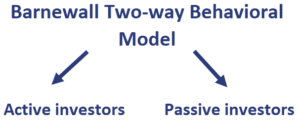Barnewall Two-way Behavioral Model
The Barnewall two-way behavioral model is a behavioral finance model proposed in 1987 by Marilyn Barnewall in a paper titled “Psychological characteristics of the individual investor”. The model classifies investors into two types (hence, ‘two-way’): passive and active investors.
The model is a so-called investors classification model since it can be used to classify investors into different categories. Two other behavioral models are the Bailiard, Biehl, and Kaiser (BB&K) five-way model and the Pompian behavioral model.
On this page, we discuss the Barnewall 2 way model in more detail. In particular, we discuss the difference between passive and active investors.
Barnewall two way behavioral model definition
As we discussed in the introduction, the Barnewall model distinguishes between passive investors and active investors.
- Passive investors: those who have not had to risk their own capital to gain wealth. For example, they may have gained wealth through steady employment and disciplined saving or through inheritance. Because they accumulated wealth passively, they tend to be more risk-averse and thus a greater need for security than active investors.
- Active investors: these investors have risked their own capital to gain wealth and usually take an active role in investing their own money. These investors are much less risk averse and are willing to give up security for control over their own wealth creation.
Active investors tend to gather a lot of information about their investments to establish a feeling of control. This can lead to overconfidence and the belief that they are taking less risk than they are actually taking. As a consequence, when active investors perceive a loss of control, their risk tolerance declines dramatically.
Model limitations
It is important to keep in mind that behavioral finance models to classify investors into different behavioral types also have limitations. In particular, many individuals may exhibit characteristics of both groups. Even if two individuals fall within the same group, it may still be needed to treat them differently due to unique circumstances. Finally, individuals may act irrationally and in an unpredictable way.
Summary
We discussed the Barnewall Two-way Behavioral Model, a popular behavior model used to classify investors. The Barnewall two-way model distinguishes between passive and active investors, depending on how they accumulated their wealth. Two other behavioral models that are related to this model are the Bailiard, Biehl, and Kaiser (BB&K) five-way model and the Pompian behavioral model.

